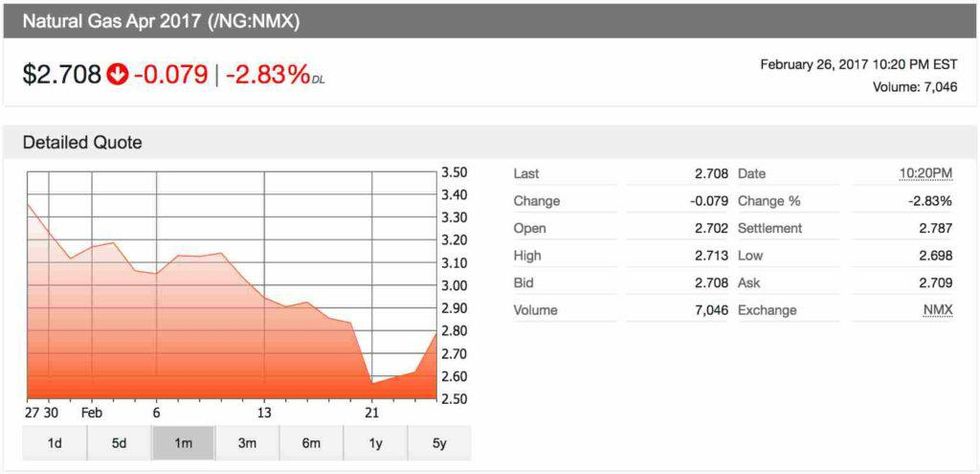
An early end to winter has pressured natural gas prices so far this year. Is relief on the horizon?
At the end of last year, natural gas prices were rallying on the back of cold weather conditions and a bullish US natural gas inventory report. Prices reached a two-year high of $3.72 per MMBtu, and there was some hope that stronger prices would continue into 2017.
A month and a half into 2017, there are some threats to that forecast. In January, the average Henry Hub spot natural gas price had fallen to $3.30. According to the US Energy Information Administration (EIA), prices were pressured by January temperatures, which were the mildest since 2006.
Since then, natural gas prices have only continued to trend downward. Last Tuesday (February 21), natural gas futures dropped 9.5 percent to reach a six-month low of $2.56. While prices were slightly higher by the end of the week, they were still well below the $3 mark.
The chart below outlines how natural gas prices have moved over the past month:
As mentioned, warmer-than-usual winter weather is largely responsible for the fall in natural gas prices. “For the most part, winter is pretty much done,” Josh Senechal, a meteorologist, told CNBC.
That’s bad news for natural gas because the fuel is used extensively for heating homes. When the weather is warmer, demand for natural gas declines.
“In the next few days, we’re expecting to see natural gas demand fall so dramatically that we’re expecting to see storage injections, which you typically don’t get for another month. It’s rare to see during heating season,” Josh Meisel, another meteorologist, told CNBC.
The most recent EIA data shows that natural gas inventories fell by 114 billion cubic feet for the week ended February 10. That’s less than the expected withdrawal of 126 billion cubic feet, and according to Richard Hastings of Seaport Global Securities, it was enough to make traders think winter demand is officially over and done with.
“The puny working gas withdrawal last week — only 114 [billion cubic feet] and below any consensus — simply sends traders firmly into the shoulder season trade,” he told MarketWatch.
Despite the early end to winter, there’s still some hope for natural gas prices in 2017. In a February 7 report, the EIA said that given “[i]ncreasing capacity for natural gas-fired electric generation, growing domestic natural gas consumption, and new export capabilities,” it is calling for the Henry Hub spot natural gas price to average $3.43 in 2017 and $3.70 in 2018.
What’s more, Royal Dutch Shell (LSE:RDSA), the world’s biggest LNG trader, said last Monday (February 20) said that while LNG supply saw a strong increase last year, demand also saw a big jump upward.
“What’s different to many people’s expectation is we’ve seen an equally strong demand growth — potentially even a more strong demand growth,” said Steve Hill, the company’s vice president for gas trading. “That’s a key message because we still keep reading about the oversupply in the industry and we just don’t see it.”
Don’t forget to follow us @INN_Resource for real-time news updates.
Securities Disclosure: I, Priscila Barrera, hold no direct investment interest in any company mentioned in this article.





